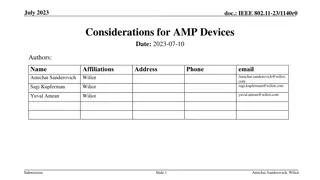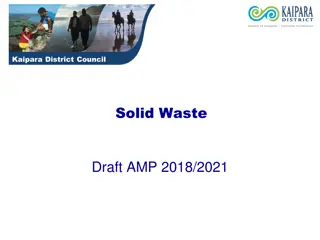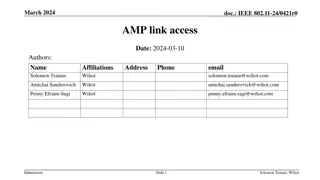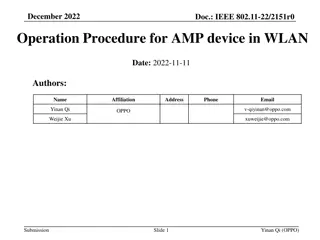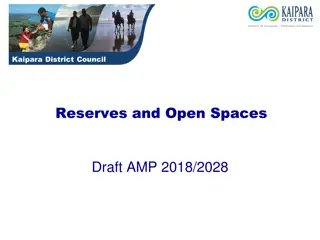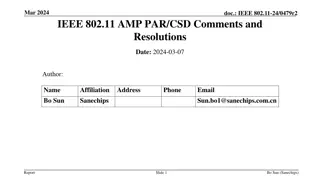
Overview of IEEE 802.11-23/1529r0 Presentation on AMP SG Progress
Explore the progress of AMP SG as presented in IEEE 802.11-23/1529r0 for September 2023. Covering aspects like requirements, deployment, operation modes, and coexistence. Discover proposed use cases and their requirements, including traffic characteristics of AMP communication.
Uploaded on | 3 Views
Download Presentation

Please find below an Image/Link to download the presentation.
The content on the website is provided AS IS for your information and personal use only. It may not be sold, licensed, or shared on other websites without obtaining consent from the author. If you encounter any issues during the download, it is possible that the publisher has removed the file from their server.
You are allowed to download the files provided on this website for personal or commercial use, subject to the condition that they are used lawfully. All files are the property of their respective owners.
The content on the website is provided AS IS for your information and personal use only. It may not be sold, licensed, or shared on other websites without obtaining consent from the author.
E N D
Presentation Transcript
September 2023 Doc.: IEEE 802.11-23/1529r0 Summary of AMP SG Date: 2023-09-11 Authors: Name Affiliation Address Phone Email Yinan Qi v-qiyinan@oppo.com OPPO Weijie Xu xuweijie@oppo.com Submission Slide 1 Yinan Qi (OPPO)
Doc.: IEEE 802.11-23/1529r0 September 2023 Abstract The aim of this presentation is to provide a comprehensive overview of the progress of AMP SG, covering below aspects Requirements Deployment topologies Operation modes Coexistence Submission Slide 2 Yinan Qi (OPPO)
September 2023 Doc.: IEEE 802.11-23/1529r0 Use Cases Use cases have been proposed in [1] UC1 Smart manufacturing: inventory, asset tracking/positioning, and environment/production line sensing and monitoring UC2 Data Center: environmental monitoring, facility monitoring and asset management UC3 Smart home: asset management, home environment monitoring and home security. UC4 Logistics and warehouse: goods tracking and inventory check UC5 Smart agriculture: monitoring of soil moisture, soil fertility, temperature, wind speed, plant growth etc., and controlling of the agricultural facilities UC6 Indoor positioning: positioning in giant shopping mall, factories, warehouses, etc. UC7 Smart Power Grid: sensing of sound, heat, pressure, etc., smart meter to achieve awareness of device/equipment status UC8 Fresh Food supply chain: Route the RTI, sense temperature etc. Use case categories Sensor Categories Positioning/ranging Identification UC#1 UC#2 UC#3 UC#4 UC#5 UC#7 UC#8 UC#1 UC#3 UC#4 UC#6 UC#8 UC#1 UC#2 UC#3 UC#4 UC#5 UC#8 UCs Submission Slide 3 Yinan Qi (OPPO)
September 2023 Doc.: IEEE 802.11-23/1529r0 Requirements [2]-[4] Peak device power consumption (mWatts) Maximum payload size (bit) Device density (per m2) Horizontal Positioning accuracy (m) Peak data rate (Kbps) Coverage (dBm) Others Type1: -30 Type2: -82 Baseline: 1.5 Optional: TBD UC1: Smart Manufacturing 256 1 3 51.2 kbps Type1: -30 Type2: -82 256 1 3 1-3 51.2 kbps UC2: Data Centre Type1: -30 Type2: -82 UC3: Smart Home 256 1 0.25 1-3 51.2 kbps Type1: -30 Type2: -82 Baseline: 1.5 Optional: TBD UC4: Logistics and Warehouse 256 1 3 51.2 kbps Type1: -30 Type2: -82 UC5: Smart Agriculture 256 1 1 10 51.2 kbps Type1: -30 Type2: -82 UC6: Indoor Positioning 256 1 0.25 1-3 51.2 kbps Type1: -30 Type2: -82 Type1: -30 Type2: -82 UC7: Smart Power Grid 256 1 10-2 10 51.2 kbps Baseline: 1.5 Optional: TBD UC8: Fresh Food Supply Chain Note 1: Coverage is calculated based on AWGN Channel Note 2: Type 1: RF powered AMP device; Type 2: non-RF powered AMP device, e.g., thermal, solar, etc. Note 3: Others include requirements only applicable to a subset of use cases Note 4: Some use cases, e.g., UC4, may need higher device density in certain scenarios Note 5: The proposed peak data rate is only the minimum peak data rate, higher peak data rate can be considered, .e.g., 250kbps, 1Mbps. 256 1 3 51.2 kbps Submission Slide 4 Yinan Qi (OPPO)
September 2023 Doc.: IEEE 802.11-23/1529r0 Traffic Characteristics AMP communication has the following traffic characteristics: Very small payload such as ID or sensor data, typically ranging from 96~256 bits Extremely low duty cycle for most of the typical use cases The traffic interval typically ranges from tens of minutes (e.g. 15min) to several hours or even days High frequency traffic (e.g. in some use cases such as logistics) is normally isolated and constrained within a specific region, e.g., factory, warehouse, etc., and AMP traffic will be the dominant service traffic in such isolated area. Extremely low channel occupation as analysed in [5] and aggregated channel occupancy percentage is less than 0.5%. Submission Slide 5 Yinan Qi (OPPO)
September 2023 Doc.: IEEE 802.11-23/1529r0 Device Constraints [6] Limited power Very low power density of Ambient powers, ranges from x uW to x mW Limited energy storage - Small capacitor for RF energy harvester (nJ-uJ) - Actual devices are usually less efficient and energy consumption of 30 nJ is reasonable Low complexity Low-complexity frequency generation needs to be supported - It is proposed to support calibrated clock accuracy of 40 ppm - To reduce the power consumption and the complexity, it is expected to support AMP STA that has an oscillator with an accuracy of 1000 ppm - Even lower accuracy clock can be used for idle time Low complexity transceiver WUR-like receiver Ultra-low complexity transmitter Limited memory and limited power budget for the memory Submission Slide 6 Yinan Qi (OPPO)
September 2023 Doc.: IEEE 802.11-23/ 1529r0 Topology 1: Direct AMP communication AMP DL AP AMP STA AMP UL RF power transfer (Optionally) The AMP STA communicates directly with the AP [7] RF power transfer can be provided by the AP Not necessarily if other ambient power is used Submission Slide 7 Yinan Qi (OPPO)
September 2023 Doc.: IEEE 802.11-23/1529r0 Topology 2: Direct AMP communication with assisting Node AMP DL Assisting Node AP AMP UL AMP STA The AMP STA communicates directly with the AP [7]-[8] Using AMP new interface or legacy interface, e.g., 802.11b/n, etc. An assisting node can: Provide RF power for the AMP STA - The power RF power transfer link can be at same or different frequency with the communication link Send wake-up signal to the AMP STA Submission Slide 8 Yinan Qi (OPPO)
September 2023 Doc.: IEEE 802.11-23/1529r0 Topology 3: Direct AMP communication with relay Node Relay Node AMP DL DL AP AMP UL AMP STA UL RF power transfer/Wake-up etc. A relay node communicates directly with AMP STA and then forwards the data to the AP [8] An AMP interface or legacy interface can be used between the relay node and the AMP STA The relay node can provide RF power for the AMP STA - The power RF power transfer link can be at same or different frequency with the communication link Submission Slide 9 Yinan Qi (OPPO)
September 2023 Doc.: IEEE 802.11-23/1529r0 Operation Mode @ Sub-1 GHz Both DL and UL communication in sub-1 GHz: DL air-interface: new air-interface with WUR-like design (i.e. MC-OOK) with scaling, e.g., SCS 312.5kHz 31.25kHz, OFDM symbol duration 4us 40us, etc. UL air-interface: new air-interface with OOK/FSK/PSK RF power transfer (when RF power is used) - Fixed AP or mobile AP, e.g., cell phone, as RF energy source - Same S1G band as communication link - Assisted Node can be optionally deployed for additional power source Submission Slide 10 Yinan Qi (OPPO)
September 2023 Doc.: IEEE 802.11-23/1529r0 Operation Modes @2.4GHz Two modes of operation@2.4GHz have been discussed. Mode 1: Both DL WUR(DL)+DSSS(UL) [7] DL air-interface: Reuse WUR design as much as possible UL air-interface: DSSS for backward compatibility - E.g., DPBSK, 1Mbps RF power transfer in other frequency band(e.g. Sub-1 GHz) or Energy harvesting can be up to implementation (if other ambient power is used) Mode 2: AMP STA compatible to existing WiFi network [8] The AMP STA is able to communicate with the AP with existing technology e.g. 802.11b/n. - AMP client STA can use a power optimized transceiver and operates in low duty cycle to communicate with existing AP. - Adding DL wake-up receiver (similar to 11ba) can further reduce the power consumption and reduce the DL response latency. and UL communication in 2.4GHz: e.g. Submission Slide 11 Yinan Qi (OPPO)
September 2023 Doc.: IEEE 802.11-23/1529r0 Benefits of AMP operation@2.4GHz A unified frequency band all over the world is beneficial to reduce the cost of AMP device via leveraging of market scale effect. It is also beneficial to support AMP application that may need to operate across different countries and regions. E.g. international logistics, supply chain management, personal belongings tracking etc. For both Mode 1 and Mode 2, it is possible to reuse the hardware of the existing AP since no new PHY waveform is introduced. In addition, it is possible to support AMP service by leveraging usage of the existing WiFi infrastructures in Mode 2. Submission Slide 12 Yinan Qi (OPPO)
September 2023 Doc.: IEEE 802.11-23/1529r0 Coexistence (1) Comparing to other technologies, 802.11 AMP technology can better co-exist with existing .11 devices It is an obvious trend to develop AMP technology in different standard organizations. Some Ambient IoT tehcnologies@2.4GHz have already been developed to fulfill the urgent market need. Developing AMP technologies with 802.11 that can well coexisted with existing 802.11 devices greatly benefit the whole 802.11 ecosystem AMP AP can provide protection for AMP client transmission and coexists well with existing .11 devices E.g. legacy preamble, TXOP sharing with client, etc. Flexibly scheduling of AMP traffic based on the channel condition in a controllable manner Submission Slide 13 Yinan Qi (OPPO)
September 2023 Doc.: IEEE 802.11-23/1529r0 Coexistence (2) AMP client has a much smaller interference footprint comparing to typical 802.11 and other technology device operated in 2.4GHz band Transmission time and power is highly constrained by harvested energy. - The harvested power from wireless power transfer is likely in the order of several uWs or tens of uW - Even at the very low transmission power of -25dBm, the active Tx consumes power in the order of several mW - Due to the energy limitation, AMP client has to operate at very low duty cycle (e.g., <1%) - Low transmission power also limit the effective interference range Leverage waveform from existing technology like MC-OOK, DSSS, etc. Submission Slide 14 Yinan Qi (OPPO)
September 2023 Doc.: IEEE 802.11-23/1529r0 Summary Progress of SG has been provided covering requirements, topology, operation mode and coexistence. Work of SG has completed and TG should be setup to further study and standardization. Submission Slide 15 Yinan Qi (OPPO)
September 2023 Doc.: IEEE 802.11-23/1529r0 Reference 1. IEEE 802.11-23/0436r8, Technical Report on support of AMP IoT devices in WLAN 2. IEEE 802.11-23/1005r0, Discussion on Requirements for AMP Use Cases 3. IEEE 802.11-23/1063r0, Further Discussion on Requirements for AMP Use Cases 4. IEEE 802.11-23/1073r0, Device Density in Logistics 5. IEEE 802.11-23/1354r0, AMP Device Channel Occupancy Analysis 6. IEEE 802.11-23/1140r0, Considerations for AMP Devices 7. IEEE 802.11-23/1190r4, Further Discussion on AMP PAR 8. IEEE 802.11-23/1195r0, Thoughts on AMP IOT and PAR Submission Slide 16 Yinan Qi (OPPO)






